Abstract
To assess the value of phrenic nerve stimulation in the investigation of diaphragm function, transdiaphragmatic pressures were measured in 20 healthy subjects and in 15 patients with diaphragm weakness, during unilateral and bilateral transcutaneous phrenic nerve stimulation at 1 Hz at functional residual capacity (twitch Pdi). Diaphragm function was initially assessed by measuring transdiaphragmatic pressure during a voluntary manoeuvre, the maximal sniff (sniff Pdi); normal readings were confirmed in the control subjects (102-157 (normal greater than 98) cm H2O in the 10 men, 79-102 (normal greater than 70) cm H2O in the 10 women) and reduced values were found in the 15 patients with diaphragm weakness (7.5-90 cm H2O in the 13 men, 23 and 53 cm H2O in the two women). Twitch Pdi during bilateral phrenic nerve stimulation ranged from 8.8 to 33 cm H2O in the control subjects and from 3.1 to 27 cm H2O in the 10 patients in whom a measurement could be obtained. Bilateral twitch Pdi correlated with sniff Pdi both in the control subjects and in the patients with diaphragm weakness (r = 0.75). Only four patients had a bilateral twitch Pdi below the lowest value seen in the control group, including the three with the lowest sniff Pdi (3.1-8.5 cm H2O). These results indicate that transdiaphragmatic pressure recorded during bilateral phrenic nerve stimulation discriminated between control subjects and patients with known weakness of the diaphragm only when this was severe.
Full text
PDF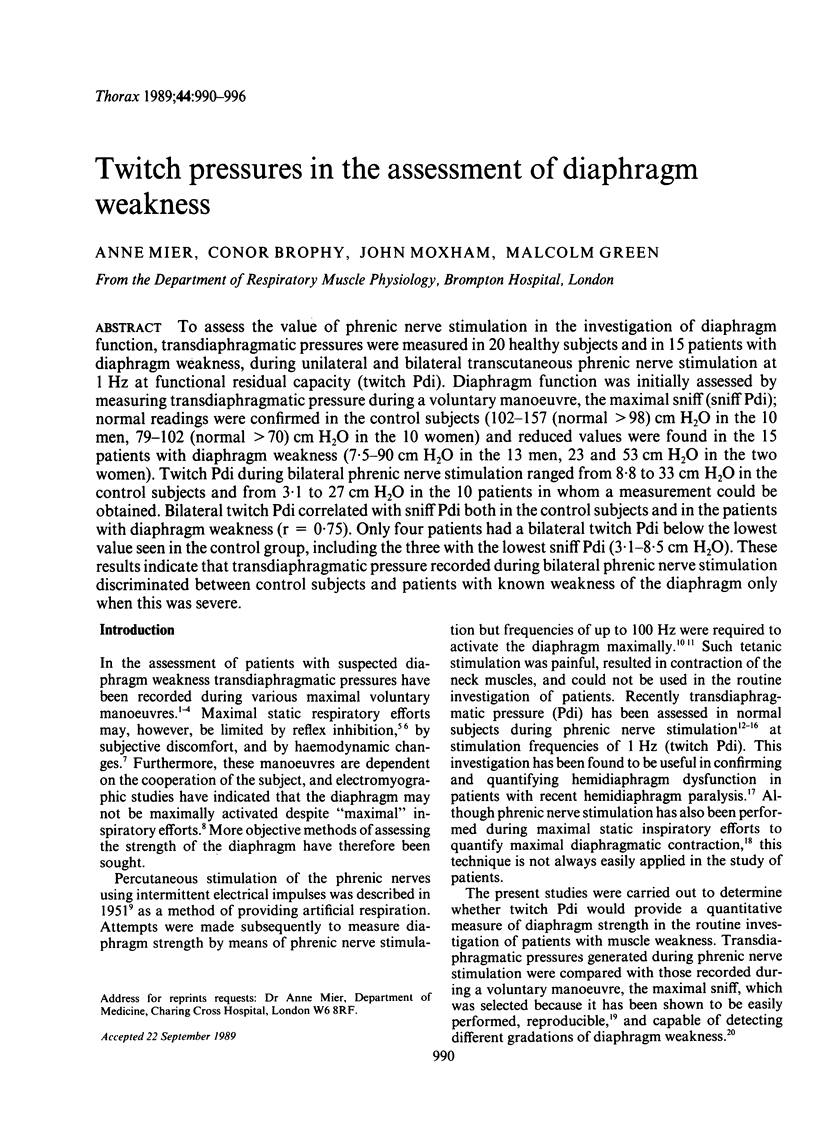
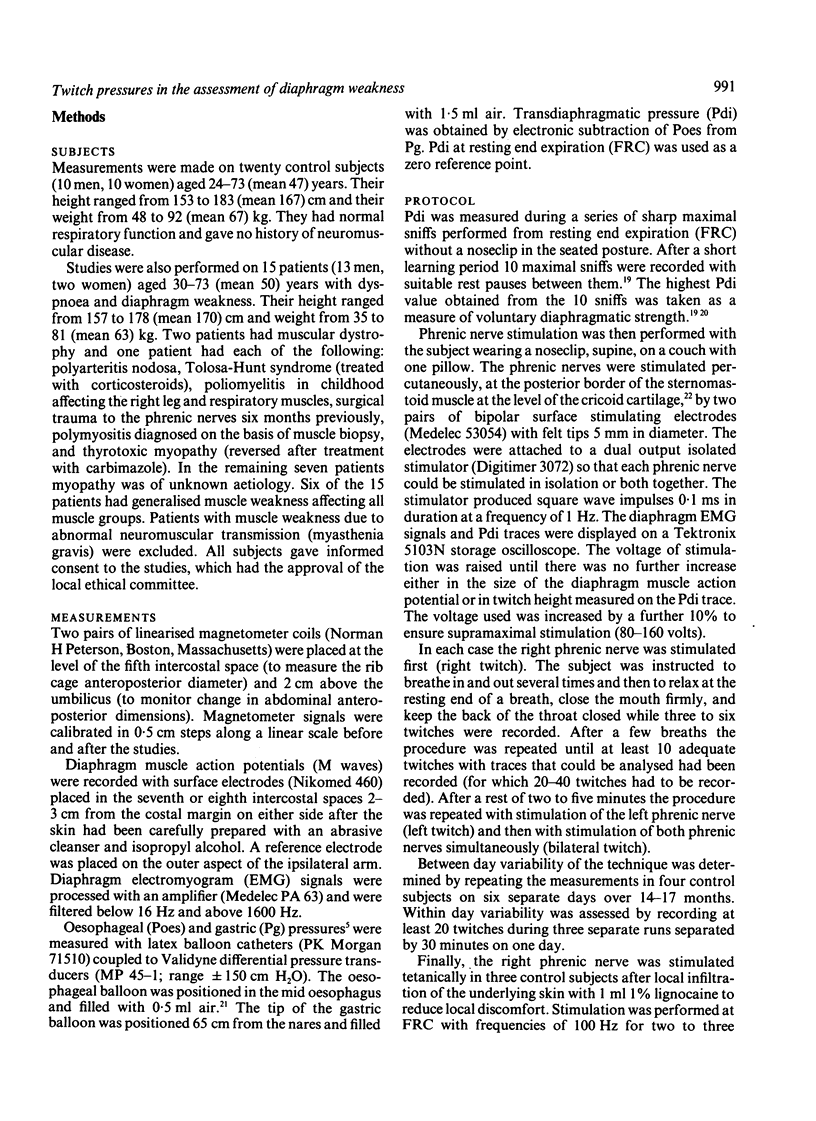
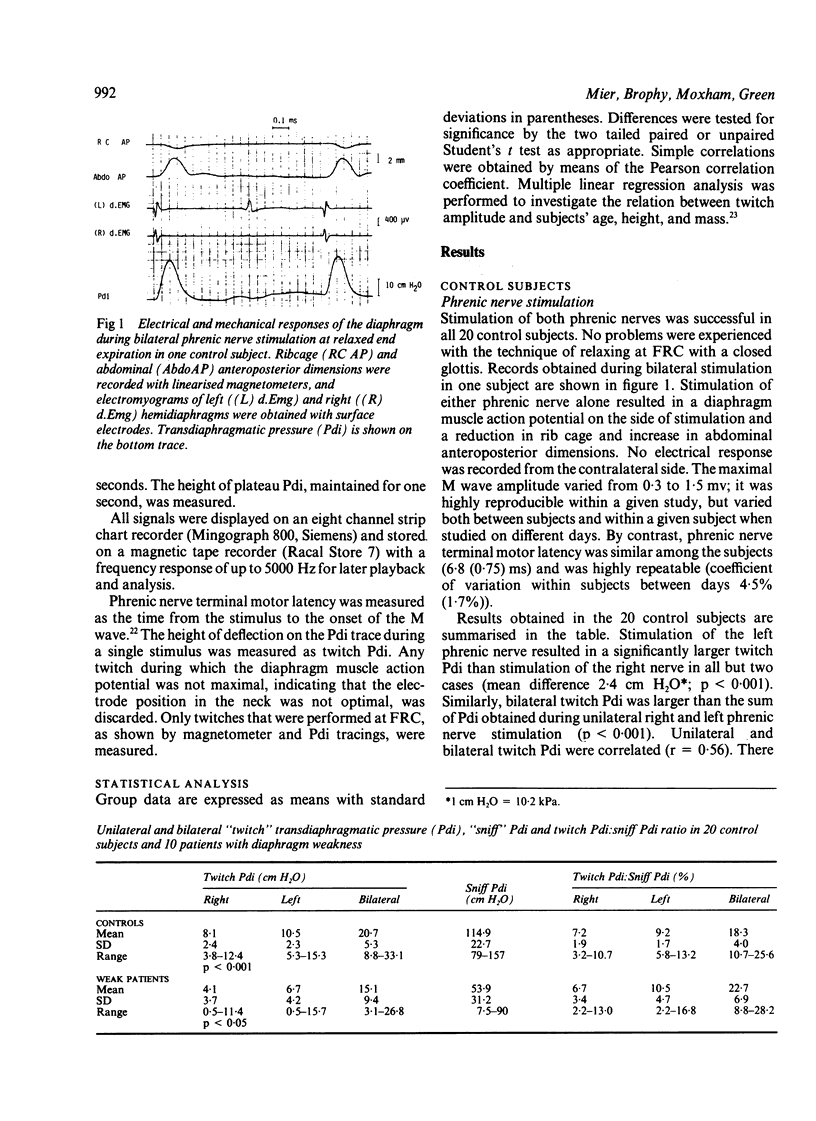
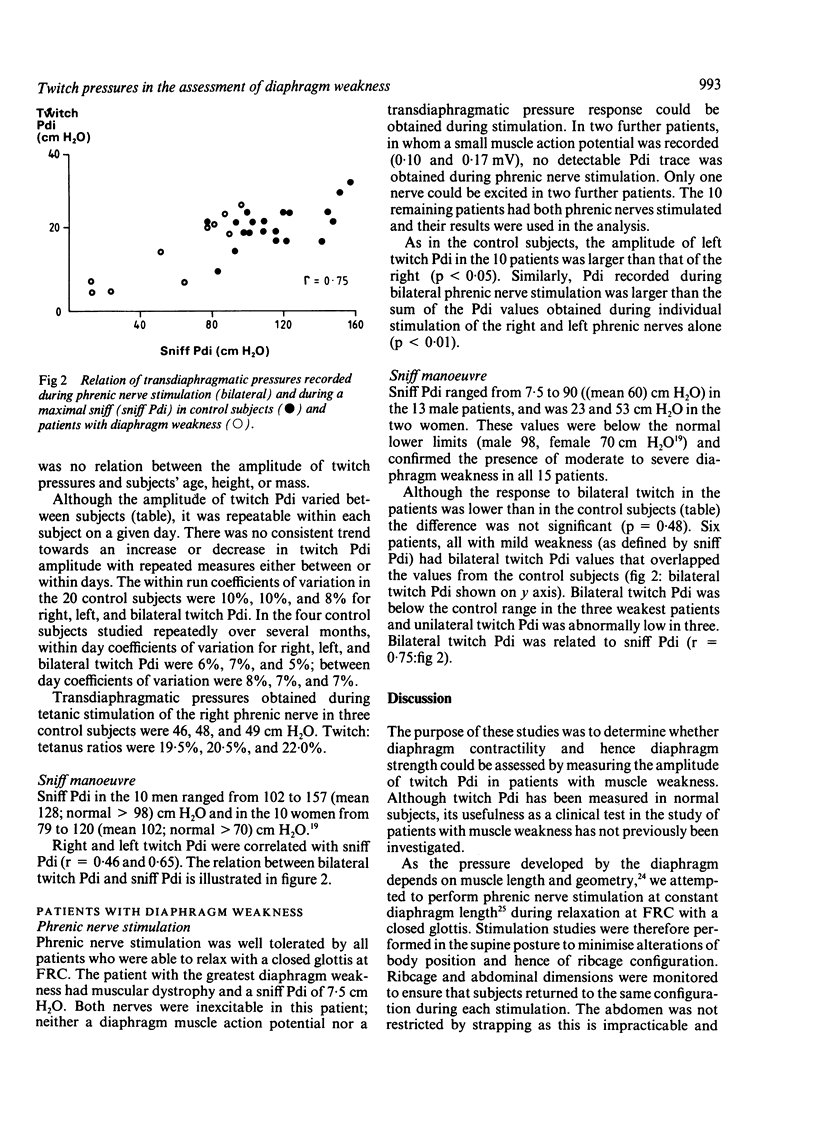
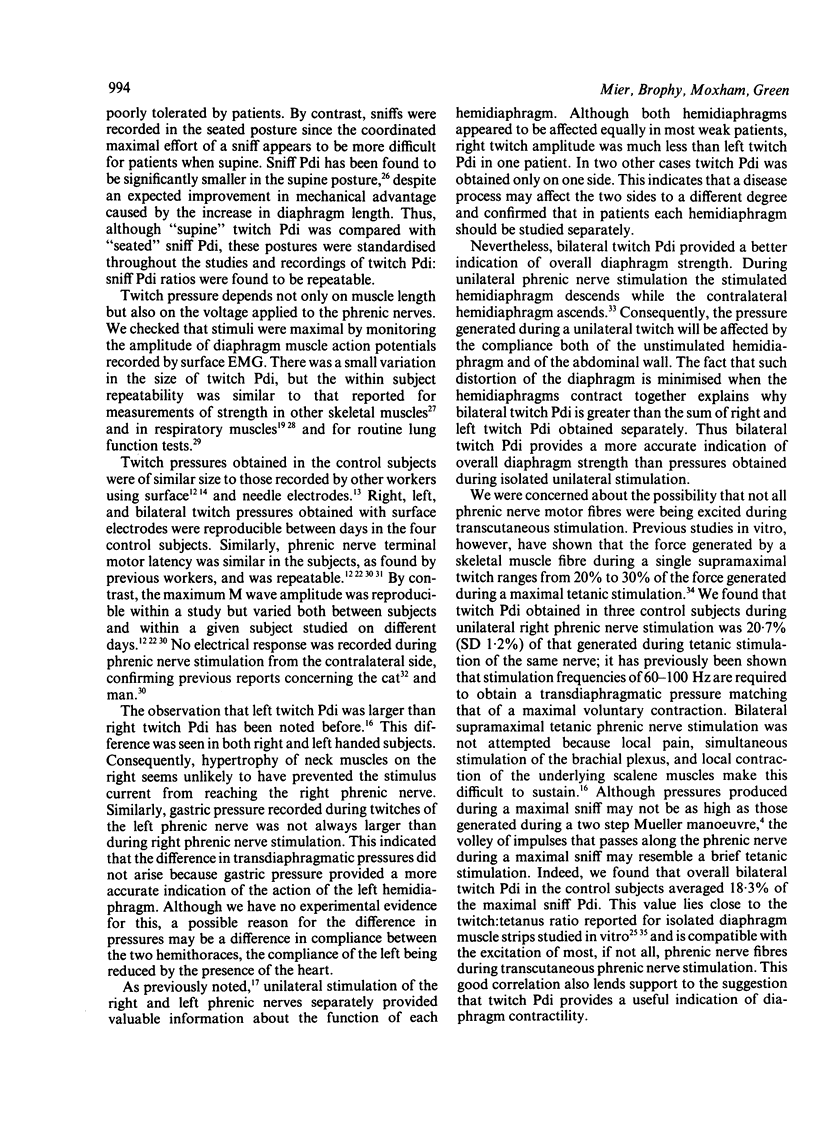
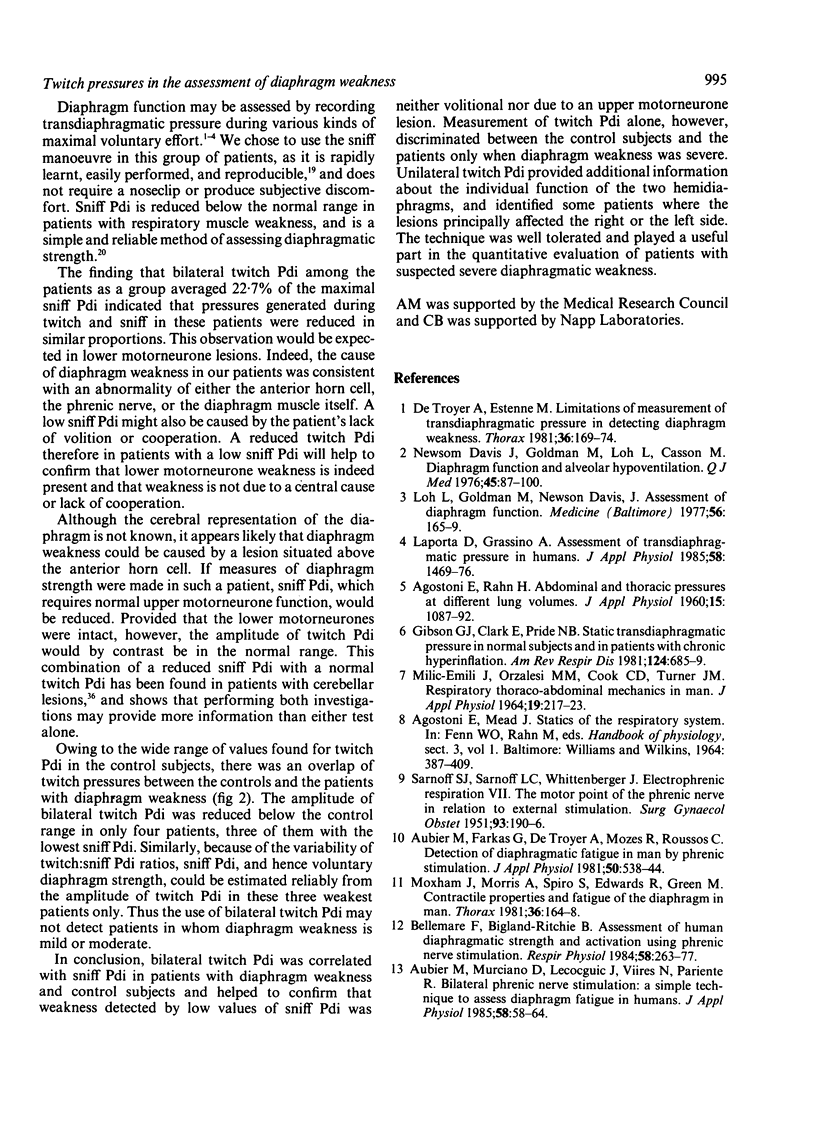
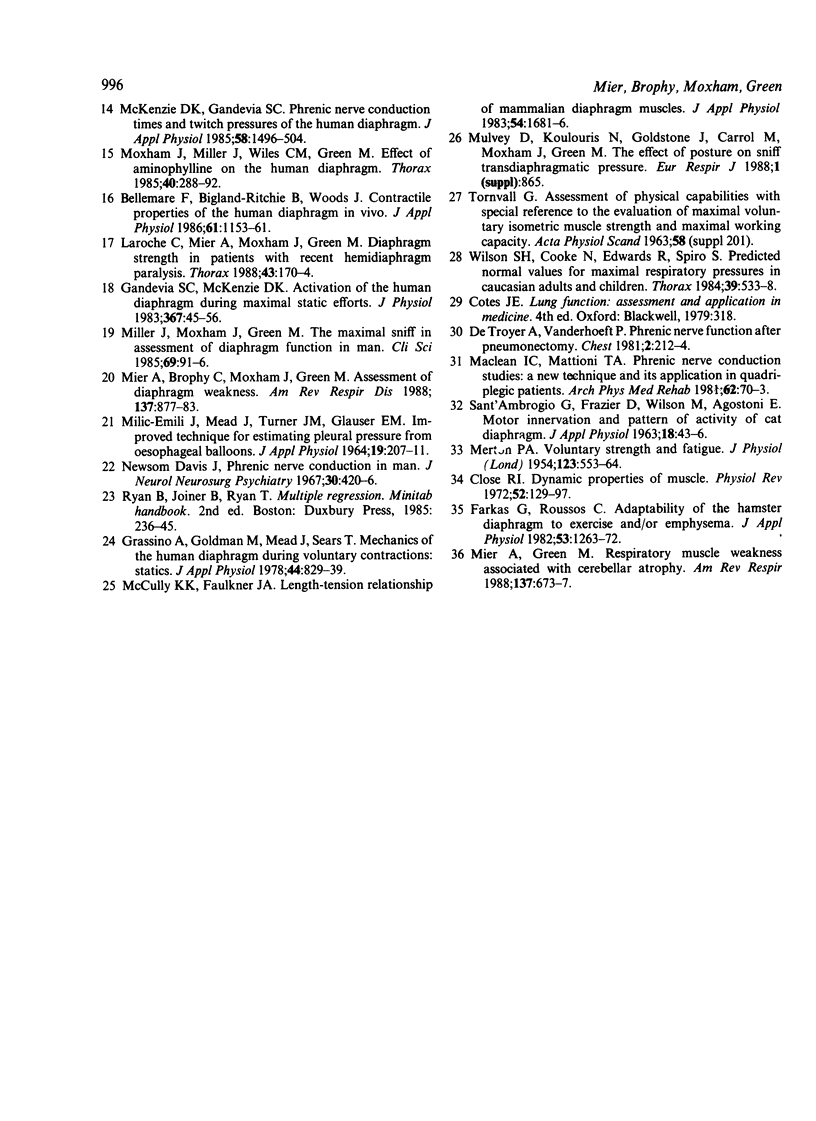
Selected References
These references are in PubMed. This may not be the complete list of references from this article.
- AGOSTONI E., RAHN H. Abdominal and thoracic pressures at different lung volumes. J Appl Physiol. 1960 Nov;15:1087–1092. doi: 10.1152/jappl.1960.15.6.1087. [DOI] [PubMed] [Google Scholar]
- Aubier M., Murciano D., Lecocguic Y., Viires N., Pariente R. Bilateral phrenic stimulation: a simple technique to assess diaphragmatic fatigue in humans. J Appl Physiol (1985) 1985 Jan;58(1):58–64. doi: 10.1152/jappl.1985.58.1.58. [DOI] [PubMed] [Google Scholar]
- Bellemare F., Bigland-Ritchie B. Assessment of human diaphragm strength and activation using phrenic nerve stimulation. Respir Physiol. 1984 Dec;58(3):263–277. doi: 10.1016/0034-5687(84)90003-3. [DOI] [PubMed] [Google Scholar]
- Bellemare F., Bigland-Ritchie B., Woods J. J. Contractile properties of the human diaphragm in vivo. J Appl Physiol (1985) 1986 Sep;61(3):1153–1161. doi: 10.1152/jappl.1986.61.3.1153. [DOI] [PubMed] [Google Scholar]
- Close R. I. Dynamic properties of mammalian skeletal muscles. Physiol Rev. 1972 Jan;52(1):129–197. doi: 10.1152/physrev.1972.52.1.129. [DOI] [PubMed] [Google Scholar]
- Davis J. N. Phrenic nerve conduction in man. J Neurol Neurosurg Psychiatry. 1967 Oct;30(5):420–426. doi: 10.1136/jnnp.30.5.420. [DOI] [PMC free article] [PubMed] [Google Scholar]
- Davis J., Goldman M., Loh L., Casson M. Diaphragm function and alveolar hypoventilation. Q J Med. 1976 Jan;45(177):87–100. [PubMed] [Google Scholar]
- Farkas G. A., Roussos C. Adaptability of the hamster diaphragm to exercise and/or emphysema. J Appl Physiol Respir Environ Exerc Physiol. 1982 Nov;53(5):1263–1272. doi: 10.1152/jappl.1982.53.5.1263. [DOI] [PubMed] [Google Scholar]
- Gandevia S. C., McKenzie D. K. Activation of the human diaphragm during maximal static efforts. J Physiol. 1985 Oct;367:45–56. doi: 10.1113/jphysiol.1985.sp015813. [DOI] [PMC free article] [PubMed] [Google Scholar]
- Grassino A., Goldman M. D., Mead J., Sears T. A. Mechanics of the human diaphragm during voluntary contraction: statics. J Appl Physiol Respir Environ Exerc Physiol. 1978 Jun;44(6):829–839. doi: 10.1152/jappl.1978.44.6.829. [DOI] [PubMed] [Google Scholar]
- Laporta D., Grassino A. Assessment of transdiaphragmatic pressure in humans. J Appl Physiol (1985) 1985 May;58(5):1469–1476. doi: 10.1152/jappl.1985.58.5.1469. [DOI] [PubMed] [Google Scholar]
- Laroche C. M., Mier A. K., Moxham J., Green M. Diaphragm strength in patients with recent hemidiaphragm paralysis. Thorax. 1988 Mar;43(3):170–174. doi: 10.1136/thx.43.3.170. [DOI] [PMC free article] [PubMed] [Google Scholar]
- Loh L., Goldman M., Davis J. N. The assessment of diaphragm function. Medicine (Baltimore) 1977 Mar;56(2):165–169. doi: 10.1097/00005792-197703000-00006. [DOI] [PubMed] [Google Scholar]
- MILIC-EMILI J., MEAD J., TURNER J. M., GLAUSER E. M. IMPROVED TECHNIQUE FOR ESTIMATING PLEURAL PRESSURE FROM ESOPHAGEAL BALLOONS. J Appl Physiol. 1964 Mar;19:207–211. doi: 10.1152/jappl.1964.19.2.207. [DOI] [PubMed] [Google Scholar]
- MILIC-EMILI J., ORZALESI M. M., COOK C. D., TURNER J. M. RESPIRATORY THORACO-ABDOMINAL MECHANICS IN MAN. J Appl Physiol. 1964 Mar;19:217–223. doi: 10.1152/jappl.1964.19.2.217. [DOI] [PubMed] [Google Scholar]
- MacLean I. C., Mattioni T. A. Phrenic nerve conduction studies: a new technique and its application in quadriplegic patients. Arch Phys Med Rehabil. 1981 Feb;62(2):70–73. [PubMed] [Google Scholar]
- McCully K. K., Faulkner J. A. Length-tension relationship of mammalian diaphragm muscles. J Appl Physiol Respir Environ Exerc Physiol. 1983 Jun;54(6):1681–1686. doi: 10.1152/jappl.1983.54.6.1681. [DOI] [PubMed] [Google Scholar]
- McKenzie D. K., Gandevia S. C. Phrenic nerve conduction times and twitch pressures of the human diaphragm. J Appl Physiol (1985) 1985 May;58(5):1496–1504. doi: 10.1152/jappl.1985.58.5.1496. [DOI] [PubMed] [Google Scholar]
- Mier-Jedrzejowicz A., Brophy C., Moxham J., Green M. Assessment of diaphragm weakness. Am Rev Respir Dis. 1988 Apr;137(4):877–883. doi: 10.1164/ajrccm/137.4.877. [DOI] [PubMed] [Google Scholar]
- Mier-Jedrzejowicz A., Green M. Respiratory muscle weakness associated with cerebellar atrophy. Am Rev Respir Dis. 1988 Mar;137(3):673–677. doi: 10.1164/ajrccm/137.3.673. [DOI] [PubMed] [Google Scholar]
- Miller J. M., Moxham J., Green M. The maximal sniff in the assessment of diaphragm function in man. Clin Sci (Lond) 1985 Jul;69(1):91–96. doi: 10.1042/cs0690091. [DOI] [PubMed] [Google Scholar]
- Moxham J., Miller J., Wiles C. M., Morris A. J., Green M. Effect of aminophylline on the human diaphragm. Thorax. 1985 Apr;40(4):288–292. doi: 10.1136/thx.40.4.288. [DOI] [PMC free article] [PubMed] [Google Scholar]
- Moxham J., Morris A. J., Spiro S. G., Edwards R. H., Green M. Contractile properties and fatigue of the diaphragm in man. Thorax. 1981 Mar;36(3):164–168. doi: 10.1136/thx.36.3.164. [DOI] [PMC free article] [PubMed] [Google Scholar]


